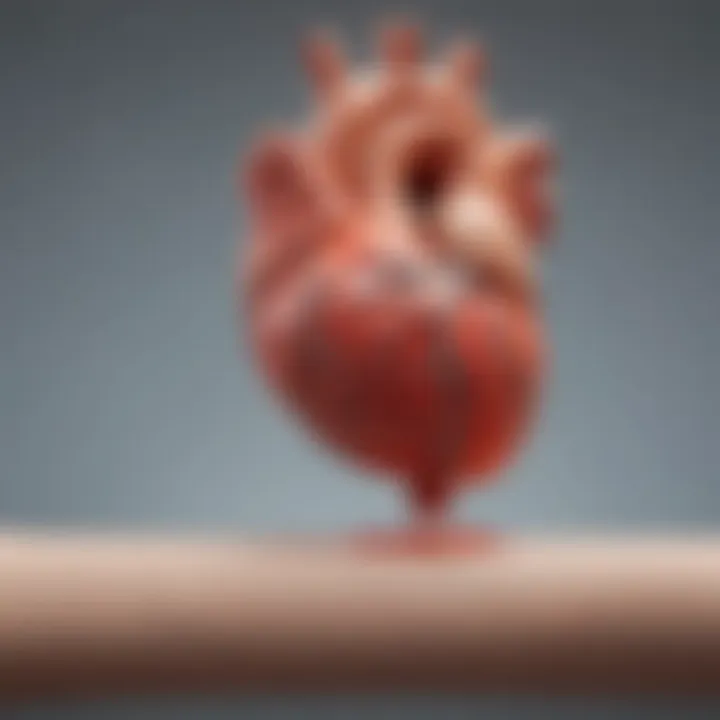Arteriosclerosis and Its Connection to Heart Disease


Overview of Research Topic
Brief Background and Context
Arteriosclerosis, often conflated with atherosclerosis, refers to the thickening and hardening of arterial walls. This gradual process can go unnoticed until serious health implications arise. The term encompasses several conditions of the arteries, with arteriosclerosis being the overarching label for hardening, while atherosclerosis specifically pertains to the buildup of plaque within these arteries. This plaque often consists of fats, cholesterol, and other substances that can restrict blood flow, leading the way to various cardiovascular diseases. Observing how this process unfolds is critical to understanding heart disease at a broader scale.
Importance in Current Scientific Landscape
The conversation surrounding heart disease continually transforms, given its status as a leading cause of death globally. As we delve into arteriosclerosis, it becomes vital to grasp how lifestyle choices, genetic predispositions, and environmental elements converge to influence cardiovascular health. Recent studies have started to decode the biochemical pathways involved in arterial stiffening, showcasing its significance in early detection mechanisms and innovative treatment approaches. For students, researchers, and professionals, fostering an awareness of how arteriosclerosis fits into the larger health landscape aids in not only academic pursuits but also practical applications to combat heart disease.
Methodology
Research Design and Approach
This exploration includes both qualitative and quantitative methodologies, ensuring a comprehensive look at arteriosclerosis and its implications on heart health. A literature review forms the backbone, providing insight from peer-reviewed journals as well as established frameworks in cardiovascular research. Such an approach balances theoretical foundations with practical findings while illuminating gaps in existing knowledge that merit further inquiry.
Data Collection Techniques
Gathering data involves analyzing patient records, conducting surveys among health professionals, and reviewing existing clinical guidelines. Through the synthesis of diverse sources, including institutions like the American Heart Association, this article aims to paint a holistic picture of arteriosclerosis.
"Understanding the mechanisms behind arteriosclerosis is not just an academic endeavor; it’s a critical pathway to improving public health practices."
Risk factors for developing arteriosclerosis are too often overlooked. These can include, but are not limited to:
- Smoking
- High cholesterol
- Hypertension
- Sedentary lifestyle
- Obesity
- Poor diet high in saturated fats
Each of those factors interacts, compounding the risk of developing heart disease over time. A keen juxtaposition of these elements aids in dissecting the overall picture of cardiovascular wellness.
As the narrative unfolds, attention will turn towards the symptoms, diagnostic techniques, and treatments available, crafting a well-rounded resource that underscores the significance of addressing arteriosclerosis in the fight against heart disease.
Understanding Arteriosclerosis
Arteriosclerosis is not just a medical buzzword; it represents a crucial topic that needs our serious attention, especially when we delve into its connection to heart disease. This condition leads to the hardening and thickening of the arteries, affecting blood flow, which is vital for overall health. Understanding arteriosclerosis equips us with knowledge that can influence lifestyle choices, drive better prevention strategies, and encourage proactive steps toward treatment. With the increasing prevalence of cardiovascular issues in society, getting a grip on arteriosclerosis becomes even more important.
Definition of Arteriosclerosis
Arteriosclerosis is broadly defined as the thickening and hardening of the arterial walls. This process occurs as an aging-related phenomenon where the elasticity of arteries diminishes, often attributed to factors such as calcium buildup, fat deposits, or inflammation. It can lead to reduced blood flow and, ultimately, serious cardiovascular complications. Essentially, when arteries lose their flexibility, they become less capable of accommodating the pulsatile flow of blood, setting off a cascade of health issues.
Types of Arteriosclerosis
Different types of arteriosclerosis behave in unique ways and have implications that vary in severity. Gaining insights into each type clarifies their effects on heart disease and helps tailor preventive measures.
Monckeberg Medial Calcific Sclerosis
Monckeberg Medial Calcific Sclerosis is characterized by the calcification of the middle layer of the arterial wall. Interestingly, while it signifies changes in the blood vessels, it typically does not block blood flow, which might make it seem less worrisome at first glance. It is notably common in older adults and can often be found without causing symptoms or requiring treatment. However, this type highlights an essential aspect of vascular aging and the need for regular check-ups, even when no immediate issues are observed in the patient's cardiovascular health.
Atherosclerosis
Atherosclerosis, on the other hand, is perhaps the most widely recognized form of arteriosclerosis. It involves the buildup of fatty deposits, known as plaques, in the arteries. These plaques can narrow arteries and reduce blood flow, leading to serious conditions like heart attacks and strokes. The presence of atherosclerosis is alarming; significant lifestyle changes—ranging from diet modifications to exercise—are often necessary to manage and mitigate its effects. The clear association of atherosclerosis with heart disease makes it a focal point in the discussion of arteriosclerosis and necessitates urgent attention.
Obliterative Arteriopathy
Obliterative Arteriopathy is less common but poses serious concerns. This condition leads to the narrowing and occlusion of arteries, significantly impacting blood flow. It typically manifests in peripheral arteries, affecting circulation primarily in the extremities. Individuals may experience leg pain or cramps during physical activity, a condition known as intermittent claudication. This disruption in circulation can pose profound dangers, extending beyond mere discomfort to the risk of critical limb ischemia. Therefore, understanding obliterative arteriopathy is crucial for comprehending the full spectrum of arteriosclerosis impacts on heart disease and the body overall.
Mechanisms of Arterial Hardening
Understanding the mechanisms behind arterial hardening is crucial for grasping how arteriosclerosis directly relates to heart disease. These mechanisms are multi-faceted, involving various biological processes that occur at both the cellular and molecular levels. Recognizing these processes can help us appreciate why arteriosclerosis is a leading factor in cardiovascular health deterioration, paving the way for disease progression.
Cellular and Molecular Processes
At the heart of arterial hardening are the cellular and molecular processes that contribute to structural changes in blood vessels. Endothelial cells, which line the blood vessels, play a significant role in maintaining vascular health. When these cells become damaged—often due to factors like high blood pressure or elevated cholesterol—they trigger a cascade of biological events.
- Smooth Muscle Cell Proliferation: Following endothelial injury, smooth muscle cells migrate from the middle layer to the intimal layer of blood vessels. This migration, paired with excessive proliferation, leads to a thickening of the arterial walls.
- Extracellular Matrix Remodeling: As smooth muscle cells proliferate, they produce extracellular matrix components. This remodeling stiffens the arteries, contributing to the loss of their elasticity.
These cellular interactions can also result in an increase in lipid deposition. Lipids can accumulate within the arterial wall, further exacerbating the narrowing of the vessel lumen. In simple terms, as the artery walls thicken and become less elastic, the overall function of the blood vessels is compromised, and this can lead to more serious cardiovascular issues.
Role of Inflammation
Inflammation acts as a double-edged sword in the context of arteriosclerosis. While it is a natural response to injury, sustained inflammation can significantly contribute to arterial hardening.
- Immune Cell Infiltration: Upon endothelial injury, immune cells, particularly macrophages, infiltrate the damaged area. Their role is to clear debris and manage repair, but unresolved inflammation can lead to far-reaching consequences.
- Cytokine Release: Activated immune cells release cytokines and growth factors, which perpetuate the inflammatory process. This encourages further recruitment of immune cells and can stimulate smooth muscle cell migration, enhancing arterial thickening.
"Chronic inflammation is like a slow-burning fire, quietly damaging the infrastructure of our vessels while we are oblivious to its presence."
Over time, this ongoing inflammation can lead to complications such as plaque formation. When plaques rupture, they can trigger clot formation, potentially leading to a heart attack or stroke. Therefore, understanding inflammation's role provides insight into preventive or therapeutic strategies against arteriosclerosis and its consequences.


Both cellular and inflammation processes intertwine in a complex web, leading to the clinical manifestations of heart disease. It becomes evident that there’s a significant interplay between these mechanisms, showing us exactly how arteriosclerosis sets the stage for cardiovascular complications.
The Link to Heart Disease
Understanding the intricate connection between arteriosclerosis and heart disease is paramount. Essentially, arteriosclerosis involves the thickening and hardening of arterial walls, which can set the stage for serious cardiovascular problems. Given that heart disease is one of the leading causes of death globally, grasping how these two issues intertwine is crucial for prevention and treatment efforts.
Pathophysiological Changes
At the heart of arteriosclerosis is a cascade of pathophysiological changes that unfold within the arteries. These alterations begin when the endothelial layer—the thin lining of the blood vessels—becomes damaged. Factors like high blood pressure, high cholesterol levels, and chronic inflammation can contribute to this damage.
Once the endothelium is compromised, it leads to a series of events:
- Lipids Build-Up: Low-density lipoprotein (LDL) particles start accumulating in the arterial walls, leading to plaque formation.
- Cellular Response: This accumulation triggers an inflammatory response, drawing immune cells to the area. Macrophages, in particular, engulf the lipids and transform into foam cells. These foam cells are crucial in forming fatty streaks in the arteries.
- Fibrous Cap Formation: Over time, these fatty streaks evolve into more complex plaques, comprising lipids, cellular debris, and a fibrous cap. If this cap ruptures, it can result in blood clots, blocking blood flow—this is a prominent cause of heart attacks.
In this way, the pathophysiological changes related to arteriosclerosis contribute directly to heart disease, illustrating why addressing these changes is essential for maintaining cardiovascular health.
Impact on Blood Flow
As arteriosclerosis progresses, its impact on blood flow becomes increasingly pronounced. Initially, the narrowing of arteries might not produce noticeable symptoms, but as the condition advances, significant issues can arise.
- Reduced Lumen Size: The thickened arterial walls and development of plaques reduce the lumen size, which inhibits blood flow. This reduced flow can compromise the oxygen supply to vital organs, and in the heart, this might lead to angina or even a heart attack.
- Increased Blood Pressure: The heart must work harder to pump blood through narrowed vessels, often resulting in elevated blood pressure. This can create a vicious cycle where increased pressure further damages arterial walls, exacerbating the problem.
- Risk of Thrombosis: The unstable plaques can rupture, yielding a clot that can either partially or completely block blood circulation. This situation can lead to severe cardiovascular events like myocardial infarctions (heart attacks) or strokes, thus making the connection between blood flow and arteriosclerosis critical to understanding heart disease risk.
In summary, exploring how arteriosclerosis links to heart disease provides invaluable insights for both individuals and health professionals. By recognizing these physiological and physical impacts, we can take strides towards proactive prevention and effective treatment options.
"Preventing arteriosclerosis can significantly lower the risk of heart disease, underscoring the importance of monitoring cardiovascular health and adopting healthy lifestyle choices."
Both the pathophysiological changes and the impact on blood flow establish a direct line of sight to cardiovascular events, highlighting the need for effective management and treatment strategies.
Risk Factors for Arteriosclerosis
Understanding the risk factors for arteriosclerosis is crucial, as these elements can influence the progression of arterial hardening and help us comprehend the greater issue of heart disease. Identifying these factors promotes awareness and highlights the importance of preventive measures to protect cardiovascular health. Primary factors contributing to arteriosclerosis often fall into genetic and lifestyle categories, while chronic conditions also play a significant role in shaping individual risk profiles.
Genetic Predispositions
Genetics hold a pivotal place in determining one's likelihood of developing arteriosclerosis. Family history can be a significant predictor, suggesting that certain individuals inherit a predisposition towards this condition. For example, if a person's parents experienced heart diseases at an early age, they might face increased risks themselves.
This inherited aspect isn't straightforward, though. It's intertwined with other factors. Some may face heightened risks due simply to their genetic background, but without the noubimous lifestyle factors, its impact could be mitigated. Still, understanding one's genetic predispositions can help individuals make informed health decisions.
Lifestyle Factors
Lifestyle choices significantly impact the development of arteriosclerosis, playing a considerable role in heart disease.
Dietary Choices
Dietary choices are foundational to maintaining cardiovascular health. A diet high in saturated fats, trans fats, and added sugars can accelerate the process of arterial hardening. Conversely, a diet rich in fruits, vegetables, whole grains, and lean proteins can provide numerous benefits.
A key characteristic of beneficial dietary choices is the emphasis on nutrient-dense foods. These choices not only lower the risk of arteriosclerosis but also support overall wellbeing. For instance, incorporating omega-3 fatty acids from sources like salmon can reduce inflammation, a contributing factor to arterial hardening. Choosing these beneficial options can add years to one's life while keeping heart disease at bay.
Physical Activity
Physical activity is another foundational element greatly influencing heart health. Regular exercise strengthens the heart and improves blood circulation. Engaging in at least 150 minutes of moderate aerobic activity weekly isn’t just good advice; it’s essential for maintaining healthy arteries.
The key characteristic of physical activity lies in its ability to counteract many risk factors, including high cholesterol and obesity. It also promotes weight loss, indirectly reducing the likelihood of developing heart-related conditions. Integrating movement into daily routines, such as taking the stairs instead of the elevator or walking during lunch, can make a substantial difference.
Tobacco Use
The effects of tobacco use on arterial health cannot be overstated. Smoking introduces a multitude of harmful chemicals into the body, leading to the narrowing and hardening of arteries. The risks associated with tobacco have been well documented, and they extend beyond just the act of smoking itself; secondhand smoke can evoke similar dangers.
Particularly, tobacco use significantly raises the likelihood of atherosclerosis, given its profound impact on blood vessels. Quitting or reducing tobacco consumption can lead to marked improvements in arterial health. It's a beneficial choice for anyone concerned about their heart health and overall longevity.
Chronic Conditions
Chronic conditions also play a vital role in the risk of developing arteriosclerosis. Each of these conditions often intertwines with lifestyle factors, creating a web of implications for heart health.
Diabetes
Diabetes is closely linked to increased risk of arteriosclerosis. The high blood sugar associated with the condition can damage blood vessels over time, accelerating arterial hardening. Managing diabetes effectively through diet and insulin can help mitigate risks, but the challenges can be substantial.
Being proactive about one's diabetes can help in reducing complications related to arteriosclerosis, making good control essential.
Hypertension
Hypertension, or high blood pressure, adds undue pressure to the arterial walls. It can weaken the arteries and increase the risk of various heart diseases. For individuals with hypertension, consistent monitoring and management through lifestyle changes and medical intervention can drastically reduce the risk of arteriosclerosis.
High Cholesterol


Conversely, high cholesterol levels represent another significant risk factor. The buildup of cholesterol in the arteries contributes to plaques, which can obstruct blood flow. Balancing cholesterol through diet and, when necessary, medication is crucial to preventing arteriosclerosis.
"Taking control of high cholesterol isn’t just about preventing arteriosclerosis; it’s about embracing a healthier lifestyle altogether."
Symptoms and Diagnosis
Understanding the symptoms and diagnostic methods associated with arteriosclerosis is crucial for addressing its impact on heart disease. Recognizing the warning signs can ultimately lead to timely intervention, which can significantly alter the prognosis. As arteriosclerosis progresses, it often heightens the risk of severe cardiovascular events. Therefore, being aware of symptoms is not just beneficial; it is vital for those at risk.
Common Symptoms of Heart Disease
Chest Pain
Chest pain is often the first symptom that comes to mind when discussing heart issues. This particular sensation can present itself in various ways, sometimes described as sharp or dull, and may manifest in different areas such as the left side of the chest or radiate to the arm, neck, or jaw. Notably, chest pain might not always signify a heart attack; it could also be linked to conditions like angina. This aspect makes chest pain particularly critical in our examination of heart disease, as understanding its nuances can direct appropriate responses to potential heart problems. The key characteristic here is variability; it can be mild or severe, transient or persistent, which influences how individuals react to it.
One feature that stands out about chest pain is its connection to emotional and physical stressors. Advantages of recognizing chest pain early include swift medical consultations and the potential for early-stage intervention, which might prevent further complications.
Shortness of Breath
Shortness of breath, or dyspnea, is another common yet often underappreciated symptom of heart disease. It could occur during physical exertion or even at rest, pointing towards cardiac compromise. The key characteristic of shortness of breath is its emergent nature, often escalating with exertion. This symptom aligns closely with heart function; as the heart struggles to manage blood flow, oxygen levels drop, which could lead to a feeling of breathlessness.
A unique aspect of shortness of breath is its relative subtlety. Some might dismiss it as mere fatigue or age-related breathlessness, which adds to its disadvantage in early recognition. Despite this, early awareness of such symptoms can inform lifestyle modifications or prompt medical evaluation, fostering better management of heart health.
Fatigue
Fatigue is sometimes overlooked when discussing heart disease symptoms, yet it plays a significant role. Unlike ordinary tiredness, fatigue associated with heart conditions can be persistent and feels unrelenting, often leading individuals to question their overall health. The key characteristic of fatigue is its insidious onset, manifesting over time as the heart becomes less effective at pumping blood.
A unique feature of fatigue in this context is its widespread impact; it can affect daily activities, emotional well-being, and even social interactions. One advantage of recognizing fatigue as a symptom is its potential to drive individuals toward a healthcare provider for assessment. However, its subjective nature can sometimes lead to misattribution, causing delays in addressing underlying health issues.
Diagnostic Techniques
As crucial as recognizing symptoms is the appropriate use of diagnostic techniques. Identifying arteriosclerosis and its consequences often requires a multi-faceted approach, employing various diagnostic tools to offer a comprehensive overview of cardiovascular health.
Echocardiograms
Echocardiograms provide real-time imaging of the heart, allowing for assessment of its structure and function. This technique uses sound waves to produce detailed images, enabling doctors to observe any abnormalities in the heart's chambers and the blood flow. The key characteristic of echocardiograms is their non-invasive nature, making them a preferred choice for initial assessments. Invaluable in evaluating heart disease progression, echocardiograms can pinpoint changes in heart size or function over time.
The unique advantage of echocardiograms lies in their ability to provide immediate feedback during a consultation, fostering timely diagnosis. However, the effectiveness of echocardiograms may be limited by patient body composition,
CT Scans
CT scans are another powerful tool, offering cross-sectional images of the body to provide detailed views of the heart and arteries. This technique is highly useful in assessing the presence of calcium deposits and blockages in coronary arteries—a hallmark of arteriosclerosis. The key characteristic of CT scans is their ability to reveal intricate details that standard tests might miss, making them a valuable ally in diagnosis.
A unique feature is their speed; a scan can be completed in a matter of seconds, providing results quickly. However, some disadvantages include exposure to radiation and the contrast agent that needs to be administered.
Blood Tests
Blood tests are often the backbone of diagnostic evaluation, revealing crucial information regarding cholesterol levels and markers of inflammation, which are significant in evaluating cardiovascular risk. The key characteristic of blood tests is their simplicity and accessibility—they can be performed in a medical office with relatively quick turnaround on results.
One unique aspect of blood tests is their ability to serve as an ongoing monitoring tool rather than a one-time assessment. The advantages of blood testing are clear, as they aid in identifying risk factors early, allowing for proactive management. However, the nuances in interpreting results may require additional visits or tests for clarity.
Treatment and Management Options
Understanding the treatment and management of arteriosclerosis is crucial in mitigating its progression and reducing the risk of associated heart diseases. By adopting proactive measures, individuals can significantly enhance their cardiovascular health. This section will delve into various options available to patients, categorizing them into lifestyle modifications, medications, and surgical interventions. Each approach carries its own set of benefits and considerations that should be tailored to individual needs.
Lifestyle Modifications
A cornerstone in the management of arteriosclerosis involves lifestyle changes. These adjustments not only help curb the progression of the disease but also foster overall well-being. The key elements include:
- Dietary Changes: A heart-healthy diet rich in fruits, vegetables, whole grains, and lean proteins can work wonders. Reducing saturated fats, trans fats, and high sodium foods is essential. For example, incorporating foods high in omega-3 fatty acids, like salmon, can have a positive impact on arterial health.
- Physical Activity: Regular exercise is a must. Engaging in at least 150 minutes of moderate aerobic activity per week can lower blood pressure and improve circulation. Even simple activities like walking or stretching can be beneficial.
- Stress Management: Techniques such as yoga, meditation, or even simple breathing exercises can help in managing stress, which is known to impact heart health.
- Avoiding Tobacco: Quitting smoking is perhaps one of the most critical steps. Smoking contributes massively to arteriosclerosis and quitting can lead to remarkable improvements in artery function.
The impact of these lifestyle modifications can be profound, enabling individuals to take control of their health and prevent further complications.
Medications
Medications play a pivotal role in treating arteriosclerosis. They help manage risk factors and improve heart health. Let's explore some common classes of drugs used in this context.
Statins
Statins are cholesterol-lowering medications. They work by inhibiting an enzyme needed for the body to produce cholesterol. This is particularly relevant since high cholesterol is a significant risk factor for arteriosclerosis. A key characteristic of statins is their ability to stabilize plaques within arteries, which can prevent heart attacks and strokes. Statins often come highly recommended due to their extensive clinical backing, making them a popular choice in treatment plans. However, they can have side effects such as muscle pain and liver damage, which necessitates regular monitoring and discussions with healthcare providers.
Antihypertensives
These medications are aimed at lowering high blood pressure, an important risk factor for heart disease. Antihypertensives can come in various classes, including ACE inhibitors and beta-blockers. Their major advantage lies in their ability to significantly reduce the risk of complications related to high blood pressure, such as heart attack and stroke. However, individuals may experience side effects such as dizziness or fatigue, highlighting the need for close management.
Antiplatelet Drugs


Antiplatelet medications, like aspirin, are crucial in preventing blood clots that can lead to heart attacks. They work by inhibiting platelets from sticking together in the blood vessels. This characteristic makes them a widely used therapeutic option for patients with significant risk factors for heart disease. While generally safe, there’s always a trade-off; they can increase the risk of bleeding in some patients, which needs consideration and discussion with a healthcare professional.
Surgical Interventions
In cases where medications and lifestyle changes are insufficient, surgical options may be necessary. These procedures aim to alleviate symptoms and potentially improve cardiac function.
Angioplasty
Angioplasty is a minimally invasive procedure to widen narrowed or blocked coronary arteries. A balloon catheter is inserted and inflated, compressing the plaque against the artery walls. One major advantage is that it can provide immediate relief from symptoms like chest pain and significantly improve blood flow. However, it’s vital to understand that angioplasty might not be a permanent fix; there may still be a risk of re-narrowing in the future.
Coronary Bypass Surgery
This surgery involves creating a new pathway for blood to flow to the heart by bypassing blocked arteries. It’s often screened for greater visual assessment to understand the severity of blockages. The key benefit of bypass surgery is improved blood supply to the heart muscle, leading to better overall cardiac function. Naturally, it's more intensive than angioplasty and requires a longer recovery time, which is an important consideration for patients and involves thorough pre-surgical evaluation.
Preventive Measures
Understanding the role of preventive measures in the fight against arteriosclerosis and heart disease is paramount. These actions can mean the difference between maintaining a healthy cardiovascular system and succumbing to serious health issues down the line. Simply put, prevention is always better than cure. By acknowledging the significance of preventive measures, individuals can take proactive steps to protect their heart health and overall well-being.
Regular Health Screenings
Regular health screenings play a critical role in the early detection of cardiovascular issues. Many people might feel perfectly fine, yet underlying conditions may silently develop, paving the way for arteriosclerosis. Scheduled screenings, including blood pressure checks, cholesterol level assessments, and diabetes screenings, can provide crucial insights into one’s heart health. For instance:
- Blood Pressure Tests: High blood pressure often is a silent contributor to heart disease. Knowing your numbers can help in addressing this effectively.
- Lipid Profile Tests: Monitoring levels of LDL and HDL cholesterol can guide dietary and lifestyle choices to keep arterial health in check.
- Glycemic Control Tests: Especially for those already at risk, keeping tabs on blood sugar levels is essential to thwart the progression of arteriosclerosis.
"An ounce of prevention is worth a pound of cure." This old adage couldn’t ring truer when it comes to heart health. Regular check-ups can empower individuals to manage risk factors and steer clear of serious complications.
Dietary Recommendations
Diet acts as both a shield and a sword when it comes to arterial health. Consuming a balanced diet, rich in the right nutrients, can significantly curb the risk of developing arteriosclerosis. Here are some dietary recommendations to consider:
- Incorporate Fruits and Vegetables: Aim for at least five servings a day. Nutrients in these foods can reduce inflammation and support optimal heart function.
- Choose Whole Grains: Switching from refined grains to whole grains can lead to better cholesterol levels and improved blood pressure.
- Healthy Fats: Emphasize unsaturated fats found in olive oil, avocados, and nuts, while cutting back on trans fats and saturated fats.
- Limit Added Sugars and Salts: High intake of these can contribute to weight gain and hypertension, further increasing the risk for heart disease.
Eating mindfully and making thoughtful dietary choices instills a sense of control over one’s health. It’s not just about what you eat, but also about creating a sustainable pattern of healthy choices.
Exercise Guidelines
Physical activity is another cornerstone of preventing arteriosclerosis. Engaging in regular exercise contributes more than just calorie burning; it enhances circulation, boosts heart health, and lowers the chances of developing heart disease. To uphold an active lifestyle, consider adopting these guidelines:
- Aim for at least 150 minutes of moderate aerobic activity each week, or 75 minutes of vigorous activity. Walking, swimming, cycling—find what works best for you and stick with it.
- Incorporate Strength Training: Activities using weights or resistance bands at least twice a week can bolster muscle mass and metabolic rate.
- Flexibility and Balance Exercises: Don’t forget stretching and balance improving activities like yoga or tai chi, as they can be beneficial for overall mobility and well-being.
Getting started may feel daunting, but every little bit counts. Carving out time for physical activities not only promotes heart health but also enhances mental well-being.
Adopting these preventive measures serves as a solid foundation for combating arteriosclerosis. Knowledge, awareness, and action can collectively work toward a healthier future.
Current Research Trends
Research into arteriosclerosis and its complex interplay with heart disease is continuously evolving. This field is important not just for those within academic circles but also for public health initiatives and clinical practices. Understanding the current trends in research could aid in developing effective treatment options, prevention strategies, and ultimately improving cardiovascular health outcomes.
Emerging Therapies
New therapies aimed at combating arteriosclerosis are receiving significant attention in recent studies. These promising approaches encompass several avenues:
- Biological Agents: Certain monoclonal antibodies are being explored that can target inflammation processes pivotal in the progression of arteriosclerosis. For example, drugs like Canakinumab are being researched for their ability to reduce inflammatory markers in patients with heart disease.
- Lifestyle Intervention Programs: Research is highlighting the effectiveness of comprehensive lifestyle changes, including tailored diets and structured physical activity regimens. Such programs aim not only to reduce body mass index but also to improve vascular function, as noted in various clinical trials.
- Advanced Drug Delivery Systems: Innovations in nanotechnology are paving the way for more efficient drug delivery specifically to arterial walls. Microparticles and liposomes are now being fine-tuned to carry medications directly to targeted areas, showing promising results in preliminary studies.
These emerging therapies reflect a shift towards targeted, personalized medicine, aiming to treat the underlying conditions of arteriosclerosis rather than merely managing symptoms as was conventional in the past.
Genetic Research Insights
Genetic research is illuminating the hereditary patterns associated with arteriosclerosis, providing key insights into its development and progression. Here are some noteworthy aspects:
- Genetic Markers: Studies are uncovering specific genetic markers linked to arteriosclerotic changes. Identifying these could lead to earlier diagnostic techniques and more individualized risk assessments.
- Gene Therapy: Researchers are investigating the feasibility of gene therapy as a method to correct genetic predispositions that contribute to arteriosclerosis. This approach holds the potential to alter the disease course significantly, especially in those with strong family histories of cardiovascular issues.
- Epigenetics: The study of epigenetic factors—how lifestyle and environmental influences can modify gene expression—is becoming increasingly relevant. An understanding of how factors like diet and stress can change gene activity might empower individuals to lower their risk through informed lifestyle changes.
"Genetic insights are paving the road toward understanding arteriosclerosis better, revealing how our DNA intertwines with lifestyle in the development of heart disease."
The marriage of genetic research and arteriosclerosis emphasizes a need for multidisciplinary approaches in both research and treatment. By leveraging insights from genetics, it is possible to design interventions that not only address the symptoms of arteriosclerosis but also its root causes, ultimately creating a proactive healthcare environment.
Closure
In this article, we tackled the essential relationship between arteriosclerosis and heart disease. Understanding this connection is not just a matter of academic interest; it speaks directly to our health in a world where cardiovascular diseases are alarmingly common. Recognizing the significance of arteriosclerosis lays down the groundwork for effective prevention and treatment strategies.
The Importance of Awareness
Awareness about arteriosclerosis is paramount. When individuals are informed about the risk factors and symptoms associated with this condition, they can take proactive steps to mitigate potential impacts on their health. For instance, knowing that factors like high cholesterol and poor diet can contribute to arterial hardening enables people to make informed dietary choices. This awareness encourages regular check-ups, helping to catch potential issues early on. Moreover, as awareness grows within communities, public health initiatives can be better tailored to address these concerns.
For healthcare providers, understanding and educating patients about arteriosclerosis creates a ripple effect, driving home the need for routine screenings. It's not just the responsibility of the medical community; everyone plays a part. As folks become more vigilant, the likelihood of severe instances of heart disease decreases, promoting healthier lifestyles and ultimately reducing healthcare burdens.
Future Directions in Research
Research on arteriosclerosis is dynamic and ongoing. The future holds exciting potential tapping into new methodologies and technologies. As we dig deeper into the genetic frameworks behind arteriosclerosis, it may open avenues for tailored interventions. For instance, genetic research could help identify specific populations at risk, allowing for early preventive lifestyle changes or customized medical treatments.
Also, emerging therapies that target the cellular and molecular processes of arteriosclerosis are gaining traction. Consider the development of drugs that could reduce inflammation at the arterial level or innovative therapies that might reverse some hardening processes. This line of inquiry can transform how healthcare professionals approach heart disease altogether.
In summary, as we deepen our understanding of the mechanisms underlying arteriosclerosis and its contribution to heart disease, we can better arm ourselves against its impacts. It is crucial that both the public and researchers continue to engage with this topic, enhancing our overall knowledge with the hope of fostering healthier futures.



